The Oberoi New Delhi resembles the set of a dystopian movie. It is late April; the hotel has been closed for renovation since the start of the month. A fleet of black BMWs gathers dust in the driveway; walls have been reduced to rubble; the swimming pool looks as if a missile has decimated it; what was once the bar is a brick shell. The ominous whirring of construction machinery echoes through the hotel’s storied corridors, where Bill Gates, Warren Buffett, and the Dalai Lama once roamed.
When EIH Ltd.—the parent of the Oberoi chain—decided to shut down the historic hotel on the edge of Lutyens Delhi for two years, it was seen as an audacious, almost foolhardy move. In India, hotels renovate wing by wing, rather than entirely down shutters. It isn’t that rare abroad: The Ritz in Paris reopened this year after nearly four years of renovations.
The Delhi hotel had contributed Rs 197 crore, or almost 15% of total revenue, last year. What rankled investors even more was that EIH had just sacrificed about Rs 81 crore in operating profits, or about a quarter of its standalone operating earnings. “Delhi is much more profitable than Mumbai, and across the board, it’s one of the most profitable hotels in the country,” EIH president Kapil Chopra tells me. In the weeks following the announcement, the stock shed nearly a fifth in value. Why fix what wasn’t broken?

The Rs 325 crore renovation is more than a fix. It is a statement of intent from a man hailed as the greatest hotelier India has produced: EIH’s executive chairman Prithvi Raj Singh ‘Biki’ Oberoi.
We’re waiting for Oberoi at his sprawling farmhouse in Kapashera, Delhi, where peacocks irreverently prance around shipshape gardens. He arrives a few minutes late and apologises profusely. Dressed in a finely cut jacket with a pocket square, trademark Cohiba cigar in hand, Oberoi is something of an anachronism at a time when wealth isn’t always accompanied by refinement. His manner befits his status as arguably the most famous alumnus of St. Paul’s, an elite boarding school in Darjeeling.
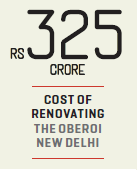
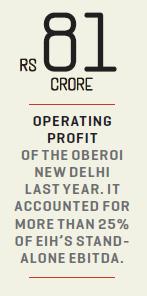
Two curious interlopers, his grandchildren, show up. “I have to play grandfather these days,” says Oberoi, as he hands them bars of Dairy Milk chocolate. He’s much more than just a doting grandfather. At 87, he is still the force that drives the business. As Zia Mody, corporate lawyer and No. 4 on Fortune India’s Most Powerful Women
list, says, he is “India’s last larger-than-life hotelier”. While he has passed on the responsibility of running EIH to son Vikram and nephew Arjun (the son of Biki’s brother Tilak Raj ‘Tikki’ Oberoi), who are joint managing directors, Oberoi remains the one who steers the ship, though he’d rather you didn’t think so.
The Delhi property occupies a delicate place in the Oberoi family. Built by Biki’s father and company founder Mohan Singh Oberoi in the early ’60s, it is one of the jewels in the crown. The hotel, originally modelled on The Intercontinental by the Bosphorus in Istanbul, has faced stagnating room prices, as new properties with larger suites and modern façades mushroomed across the capital.
“Delhi is in flux,” wrote global hospitality consultant Horwath HTL in a report published August. “[Luxury] hotels had a small gain in occupancy [in the first half of calendar year 2016] but sacrificed average daily rates by 1.6%; this segment needs to review its strategy.”
To be certain, The Oberoi New Delhi had fended off competitors before. Take for instance, Shangri-La’s Eros Hotel. It arguably occupies an even more prime location in Lutyens Delhi, one of the most elegant urban landscapes in the world. The Hong Kong hotel chain had opened in 2005, but failed to match The Oberoi’s standards.
However, the present situation is different. If Oberoi is to protect his lofty rates and image, he needs to act. That’s why Oberoi threw his might behind the renovation, with the make-or-break urgency of a man on a mission. This overhaul can be read as his swansong. To spearhead it, Oberoi has hired Adam Tihany, a New York-based designer and architect known for his work on the Four Seasons in Dubai and the Mandarin Oriental in Las Vegas. The décor will be contemporary, though the hotel will retain its classic vibe and feature artwork by Edwin Lutyens himself, Oberoi tells us. It won’t be an all-suite hotel as was speculated, but the rooms will be larger than before; the restaurants will offer a broader array of Indian cuisine, he adds.
Hospitality has never been tougher, Oberoi says, as an aged Nepalese attendant serves us tea in an ornate bone china set. It is a seismic comment from a man who has witnessed firsthand all the trials and tribulations of modern India, and its growth from a British colony to a liberalised economy. Read that as an admission that he faces his sternest test yet.
“Oberoi has never welcomed competition,” says Ajit Kerkar, who helped build Tata Group’s Taj Hotels chain along with former marketing director Camellia Panjabi. “It was a monopolistic view his father fostered and that [Biki] supported after he took charge.”
Once, The Oberoi had just a handful of local rivals—The Taj chain, owned by the Tatas, was the fiercest. Now several foreign brands with deep pockets—Four Seasons, Sofitel, St. Regis, Hyatt, and Marriott—jostle for position in the world’s fastest growing major economy. The travel and tourism industry’s contribution to the economy is expected to more than double to Rs 18.4 lakh crore or 7.2% of GDP by 2026, the World Travel and Tourism Council predicts. Domestic travellers account for most of the demand for hotels. This potential has everyone interested.

The game changer is Marriott’s $13 billion (Rs 86,896 crore) acquisition of Starwood that has created a behemoth with 30 brands and more than one million rooms worldwide. Economics dictates that a hotel group of its heft will skew rates and occupancy levels worldwide.
The capital at the disposal of global brands is dizzying. Marriott International plans to open 90 hotels in India over the next three to four years, Rajeev Menon, the company’s chief operating officer, Asia-Pacific (excluding Greater China), tells me. By 2020, it will have nearly 200 hotels, almost double the size of India’s largest hotel chain The Taj. Marriott already has 18,000 rooms and 85 hotels in India under its brands such as JW Marriott, Renaissance Hotels, and The Ritz Carlton.
Canadian luxury hotel chain Four Seasons is also adding half a dozen new hotels here by 2020, as per media reports. (Oberoi and Isadore Sharp, the founder of Four Seasons, had once discussed joining forces in India, but failed to agree on whose brand should be on top.) Meanwhile, Hyatt Hotels plans to open up to 10 properties under the Hyatt Place brand by 2020. EIH just doesn’t have the financial might to take on its minted global competitors. What emerges is a David vs. Goliath narrative, where Oberoi’s role has been flipped from giant to minnow. Seen another way, till recently, he set the agenda: now his competitors do!
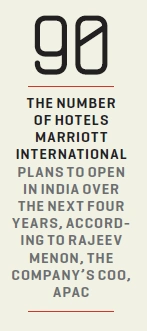
Oberoi can no longer match them on scale. EIH—the No. 3 hotel business behind Indian Hotels (Taj), and ITC—has a portfolio of just 28 hotels, along with two Nile cruisers, and one luxury backwater cruiser in Kochi.
The sobering reality today is that there is a glut in rooms. Foreign tourist arrivals have also faltered. Ratings agency ICRA estimates occupancies increased to around 63% in fiscal 2016, from 60% in fiscal 2015, though average room rates continue to languish at previous-year levels. The implication is that most hotels are trying to fill rooms at safer rates than risk the fight for business at superior prices.
However, prices at The Oberoi are about 20% higher than competitors such as Four Seasons. “The Oberoi is aggressive in its pricing and hungry for business, whereas The Taj seems to have missed out because of a complex sales structure [that involves a pricing structure solely based on rooms],” says a travel operator, who declines to be named. Achin Khanna, director at hospitality consultancy HVS, says Oberoi goes against the grain by telling guests “if you see value in us then stay at our rates”.
This isn’t merely a contrarian stance, it is a carefully curated blueprint, wherein Oberoi is sticking to his strengths. “We want to be the best, not the biggest.”
EIH’s future constructions illustrate his high-value approach. The Oberoi Sukhvilas, a 20-acre site near Chandigarh, will offer luxury villas surrounded by manicured gardens. It is also building The Oberoi Rajgarh Palace, near the ruins of Khajuraho in Madhya Pradesh, while plans for a beach-front hotel in Goa and luxury residences in Bengaluru are in place.
Even old foe Taj respects Oberoi’s resolve. Says Rakesh Sarna, managing director at Indian Hotels: “The Oberoi hasn’t allowed itself to be commoditised in this market, and that’s a very difficult thing to do.”
Oberoi is essentially taking the battle to the big hotel chains on terms he understands: premium service. “A good customer is not going to say that Oberoi has 5,000 or 50,000 rooms but will talk about the experience,” says Oberoi.
He has always put customers at the top of his pyramid of priorities, a mandate passed on to his successors. He has gone to great lengths to pander to guests, sometimes at the cost of revenue. The Oberoi doesn’t host weddings anymore, for instance. The hullabaloo inconvenienced guests, Oberoi tells me. His hotels have also restricted memberships for swimming pools and gyms.
Anand Mahindra is one of the chain’s high-profile admirers. The head of the Mahindra Group narrates an anecdote to illustrate The Oberoi’s charm. He once asked for a glass of water during a session at the gym. A polite, well-dressed gentleman promptly served him. Later that evening, he met the man at an event. It was Vikram Oberoi, Biki’s son. The hotel managers have also been around for years and know exactly what each customer wants, he tells me. That personal touch is what makes The Oberoi special, Mahindra says.
Jeweller Nirav Modi, who spends at least 200 nights a year in hotels across the world, believes The Oberoi’s service is world class, and compares it favourably with the Peninsula, Mandarin Oriental, and Four Seasons.
Oberoi’s strategy is paying off. The Oberoi and Vilas properties filled about 62.4% of their rooms at a rate of Rs 15,206 in fiscal 2016. In comparison, The Leela, which matches The Oberoi in its idea of luxury if not in scale, filled 62% at Rs 12,702 a room, excluding its new Shahdara hotel, vs. 61% at Rs 12,208 last year, according to calculations based on an investor presentation in July. The Leela’s Udaipur and Goa properties represented most of the increase in rates. But others recorded declines, including the hotels in Mumbai, Chennai, and Gurgaon.
The Leela, owned by the Nair family, has been hit hard by the influx of new players, and has been bleeding money. Its troubles provide a cautionary tale.
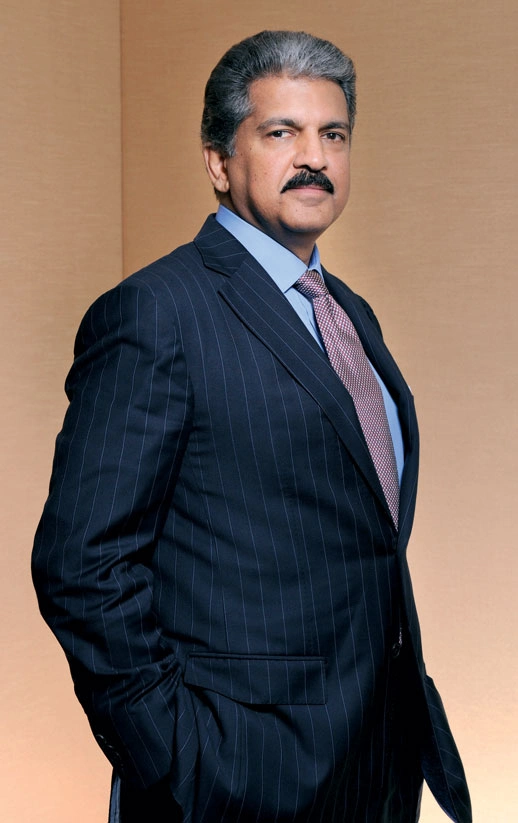
There was a time when Oberoi had flirted with the idea of a mid-range brand. He ultimately dropped the idea to the relief of the likes of Patu Keswani, who is planning an initial public offering for his 3- and-4-star Lemon Tree hotels. “Maybe I could have started a 2- and-3-star brand. I had been very tempted, but then you have to have big volumes for that game,” says Oberoi.
Oberoi’s thinking can also be ascertained from what he didn’t do. He smartly resisted the lure of planting flags. It simply didn’t make economic sense, Oberoi explains. “If I were to buy a hotel in London today, it would cost at least £2 million (Rs 17 crore) per key.” It’s one tenth of that here.
The Taj, in comparison, had embarked on an ill-fated acquisition spree across cities such as Boston, New York, and Sydney. Several of those properties were sold at a loss, and the onerous terms of the lease for Pierre in New York were such that even an exit is a challenge.
Oberoi recognised that to overreach would have been to commit hara-kiri. For now, his focus is on the gateways to the West, he says. Upcoming hotels include properties in Qatar, Morocco, and the United Arab Emirates. Arjun Oberoi, who heads expansion projects tells me his uncle takes special interest in new developments, and spends a lot of time discussing them.
Just offering high-quality service isn’t enough anymore. The arrival of a disrupter has rattled hotel chains. Emboldened by huge financial backing, sites like Airbnb.com, Oyo Rooms, etc. are gaining ground.
Airbnb, which already has lots of cash, raised $555 million in new funding, Fortune reported in September. It is dipping into that cash pile to fund its global expansion. The startup, which has 18,000 members across 100 Indian cities, has set its sights on growth here, the company’s country head Amanpreet Bajaj tells me. Bajaj hopes features like 24-hour wireless Internet, air-conditioned apartments, and safe localities will give Airbnb an edge; while its recent tie-up with India’s biggest media company The Times Group will help boost awareness.
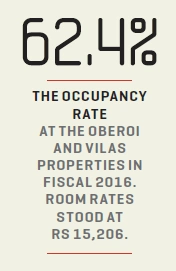
Airbnb has been so disruptive to traditional hotels that it is worth $30 billion, the fourth most valuable startup behind Uber, Didi Chuxing, and Xiaomi, and equals the combined market capitalisation of Starwood and Marriott. Sandeep Singhal—co-founder of Nexus Venture Partners, an investor in Snapdeal and OLX—says Airbnb hasn’t just opened up a segment of budget travellers, it is transforming the way peripatetic executives book their stays. Cost-conscious operators, especially small and medium businesses that form the backbone of the Indian economy, have turned to the service, says Singhal, who has invested in online booking service Stayzilla.com.
Kavikrut (who goes by a single name), chief growth officer for Oyo Rooms, feels hotel companies need to adapt quickly. The convenience of the new model, which offers several customisation options such as earlier check-in times, has spurred impressive growth. Oyo, funded by Japanese billionaire Masayoshi Son’s Softbank, now offers 90,000 rooms, within three years of operations, Kavikrut claims.
As a luxury chain, The Oberoi isn’t in pitched battle with the likes of Airbnb and Oyo, though some online ventures have begun stepping on its toes. Onefinestay.com, for example, offers accommodation at luxury townhouses and villas. AccorHotels, one of Europe’s largest hotel groups, bought Onefinestay for about $169 million in April, and it is spending a further $73 million to expand the high-end hotel booking service’s worldwide presence.
The once symbiotic relationship between hotel chains and online travel agencies (OTAs) is also crumbling. While OTAs, such as Bookings.com and Tripadvisor, offer consumers an array of choices and fill up hotel rooms, they do not develop what is considered the holy grail of customer relations: brand loyalty.
If Oberoi’s brand is to survive, and emerge stronger, he recognises the importance of guest loyalty. Promotions have become crucial as few things distinguish one premium chain from another for many business travellers. Here’s what he is up against: Almost 85 million people belong to the Marriott Rewards and Starwood Preferred Guest loyalty programmes.“When we look at the [merger], the reasons behind it were distribution and loyalty, because we are competing with the Airbnbs and the OTAs, and to do that you have to have the muscle,” says Marriott International’s Menon.
Just days before we went to press, the Taj and Shangri-La joined forces to increase their reach and market share, by launching a new guest loyalty programme called Warmer Welcomes. The loyalty programme combines Taj’s InnerCircle and Shangri-La’s Golden Circle rewards programmes.
Partha Chatterjee, a former Taj hotelier and now a director at Silver Needs Hospitality, recollects how Oberoi once told him that the perfect hotel would “combine The Taj’s marketing and sales nous with The Oberoi’s operations”.
Marketing has been one of Oberoi’s biggest failings, but he is eager to make amends. “This will be a challenge,” he tells me. For now, Oberoi is taking a page from his chief rival. Under Sarna, the Indian Hotels chief, the Taj Group has sharpened its digital game. It has lured a handful of digital executives, and improved its online booking interface.
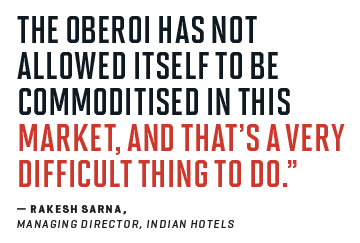
The Taj is also spending on marketing and promotions to gain the upper hand in the tug-of-war with OTAs. This not only helps attract repeat guests, but also protects margins as OTAs charge up to 20% of the room rate. EIH has also reduced dependence on OTAs in recent quarters, Oberoi says.
To free up money for marketing amid high real estate prices, Oberoi is pushing for management contracts, rather than ownership. “It’s going to be management contracts from here on,” Oberoi asserts. That is reflected in the company’s slate of upcoming hotels and luxury residences across of the world from Marrakech to Chandigarh—they are all managed, rather than owned. Earlier his mantra had been to own as well as operate properties. “It was an important mindset to have an owner’s money versus an operator’s money,” Vikram Oberoi reminds me.
Almost all global hotel companies have adopted what is known as an “asset light” model, which has allowed them to finance more targeted marketing strategies to strengthen their base of loyal customers.
Oberoi raves about a study on tech disruption by Mark Woodbridge, a Ph.D. candidate at Western Sydney University’s School of Business and former dean of the Oberoi Centre of Learning and Development, the group’s hotel management institute. He has sent the seven-page document, with relevant paragraphs underlined, to his top managers. “Change in the context of creative destruction implies that better and newer are preferred by organisations and individuals over older products which make them obsolete,” reads one line.
What’s happening here is similar to the disruption in the auto industry caused by the likes of Uber, Tesla, driverless cars and so on, says Mahindra. “Even so, there’s always that one car which gives you an experience like no other.” Mahindra compares The Oberoi to Ferrari, the Italian high-end sports car brand that is worth around $7 billion today.
At stake here is Oberoi’s legacy. In recent years, he has taken several measures to shield it. One of his most astute moves: EIH doesn’t own the rights to the Oberoi brand. Those remain in the family. This is significant as it protects the brand from overtures.
The hawks have been circling in recent years. Over the first decade of the 21st century, ITC had built up a stake of a shade under 15% in EIH which it still owns. Though Oberoi has always maintained EIH wasn’t an acquisition target, he sprung into action to prevent ITC from gaining control and spoke to various friendly parties.
There was also speculation of a merger between EIH and EIH Associated Hotels, a listed joint venture with the Rajan Raheja Group that runs the Trident brand. But that didn’t fructify.
It was around this time he made what Fortune India in February 2012 described as his shrewdest move to safeguard his legacy. He engineered an investment by India’s richest man Mukesh Ambani. It was a good fit as the Oberois and Ambanis were close.
In August 2010, Mukesh Ambani-owned Reliance Industries (RIL) acquired 14.2% of EIH, for Rs 7,200 crore. It currently owns roughly 20%. Ambani’s investment finally squashed speculation of a takeover, and EIH retained its independence. The Oberois, as the main promoter group, own about 35% of the company. There is no formal agreement with Reliance; the understanding is on a handshake basis, Oberoi tells us. ITC and Reliance did not respond to requests to participate in this story.
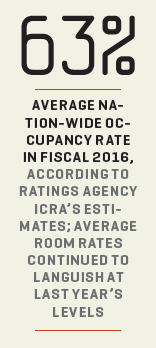
The Ambani investment ended a period of uncertainty that had lasted a decade. Reliance also gives Oberoi a powerful strategic partner, and has opened up avenues of business. EIH has sent a team to gauge progress at Reliance’s development in Bandra-Kurla Complex, Mumbai, a huge project involving apartments, restaurants, and gardens, Oberoi tells me. Reliance also has a large plot of land in Vashi, Mumbai, where Ambani will provide the cash to build, while Oberoi will manage the property.
The next generation of Oberois has big shoes to fill. Though Oberoi’s heir Vikram and nephew Arjun are capable leaders, it remains to be seen if they have the fire that makes Biki so formidable, say insiders.
The removal of Cyrus Mistry as chairman of Tata Group illustrates the importance of tradition to India’s old businesses. Mistry had distanced himself from many of his predecessor Ratan Tata’s key policies. While Tata had targeted blockbuster global acquisitions such as those at Indian Hotels, Mistry focussed on disinvestment.
Inheritance has often been problematic in Indian family businesses, from the Ambani brothers fallout, to the feud between the Akoi siblings, the family behind The Imperial hotel, one of The Oberoi’s long-time Lutyens Delhi rivals. There was a time when it was speculated that Oberoi’s son and nephew were vying for his throne. Oberoi has since named Vikram as his successor. He emphatically plays down concerns on succession. For starters, Vikram and Arjun share a fine working relationship, and remain close.
Responsibilities have been split between them. Vikram looks after day-to-day operations of the hotel, while Arjun handles developments and new projects. EIH president Chopra, meanwhile, is the professional hand who ties it all together. There is little to suggest the status quo will be disturbed.
Oberoi isn’t worried that his successors may break from his ideals; they’ve been groomed by him, after all. A figure like Oberoi can cast a long shadow, but the landscape has changed since he took on a larger role in EIH following his brother’s death in 1984. You don’t need a big name in charge anymore, what you need is strong management, Oberoi tells us.
What strengthens his confidence in the future is The Oberoi Centre of Learning and Development. Many top hotel executives have graduated from the school, including Chopra. Each time a hotel opens in Dubai or a luxury ship passes by Mumbai, EIH’s hotels lose staff, Oberoi complains. “I lost my entire kitchen once.”
Though he’s planning for the future, Oberoi has no plans to step down. He appears in good health, though he smokes two cigars a day. His father had lived until 103 and remained in charge until 100. There is no reason to doubt Oberoi can at least match him. He remains the unrivalled hands-on manager he’s always been. “Nothing moves without him,” says his hotelier cousin Brij Raj ‘Diamond’ Oberoi.
Oberoi is a stickler for detail. He wants to know the minutiae such as what materials are used in construction, says Arjun Oberoi. He even insists on seeing photographs of furniture and fixtures. It is as if Oberoi is constantly building a database of knowledge, Arjun adds.
Oberoi’s perfectionism is the stuff of legend, though he dismisses the notion. “You can actually never have perfection no matter what you do. I don’t think perfection exists, but we try however,” he says.
When his grandchildren have grown up, Oberoi may be remembered as the man who refused to cut corners; the man who fended off giants to forge a resilient luxury brand. His enduring message: size doesn’t matter, quality does.












Leave a Comment
Your email address will not be published. Required field are marked*